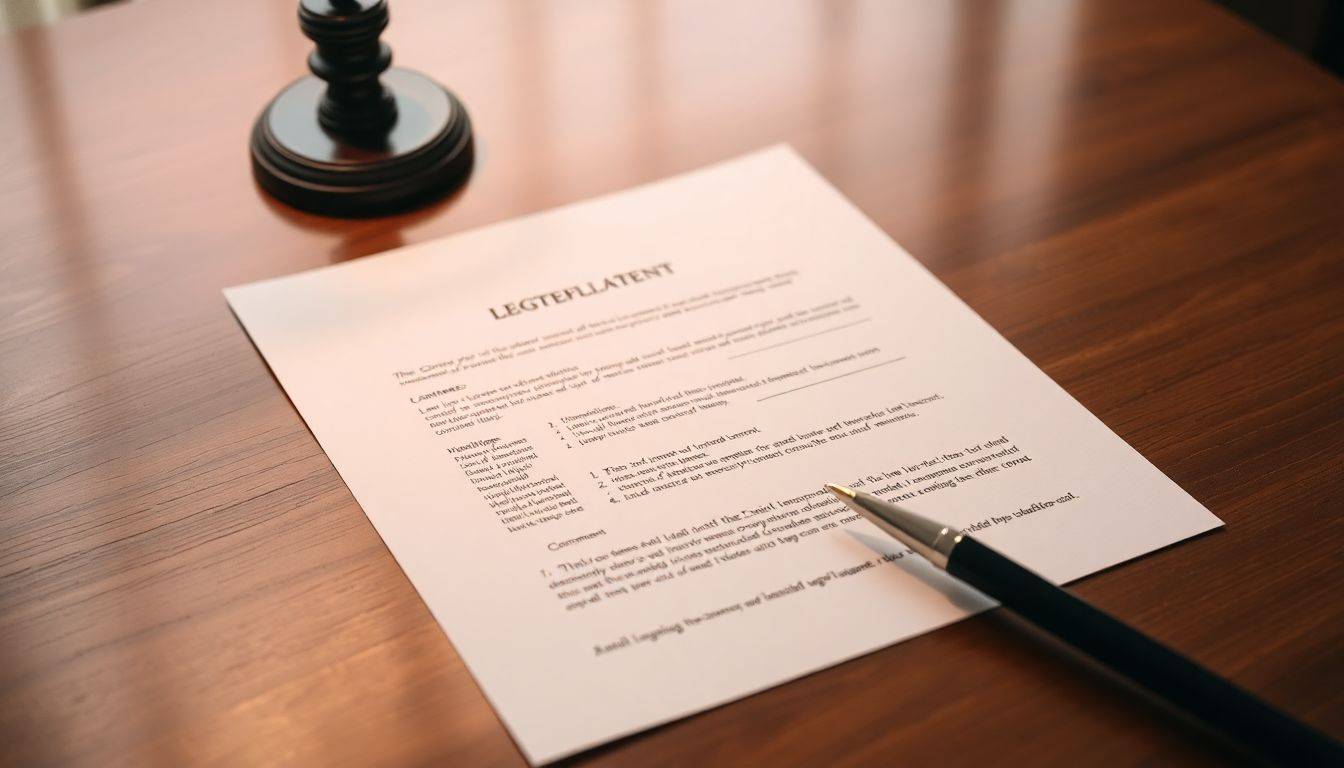Feeling overwhelmed at the thought of writing an affidavit? You’re not alone; legal documents can be intimidating, even for the best of us.
But hey, it’s not as scary as it seems. Stick with me, and you’ll be drafting affidavits like a pro in no time.
We’ll cover everything from key components to structuring your document properly, using clear language, and avoiding common pitfalls.
Key Takeaways
- Start by titling the document as “Affidavit” and introducing yourself with full legal details.
- Include a statement of truth affirming the accuracy of your information.
- Present facts in clear, numbered paragraphs, sticking to one fact per paragraph.
- Use clear and formal language; avoid legal jargon and emotional expressions.
- Be aware of legal considerations; ensure truthfulness and relevance of information.
- Sign the affidavit in the presence of a notary public to make it legally binding.
- Attach supporting documents as exhibits, properly labeled and referenced.
- Avoid common mistakes like omitting essential information or including opinions.

1. Steps to Write an Effective Affidavit
Writing an affidavit might seem daunting, but breaking it down into simple steps can make the process smoother.
Here’s how you can craft an effective affidavit:
1. **Title Your Affidavit**: Begin by clearly indicating that the document is an affidavit. Place the word “Affidavit” at the top, centered and in bold.
2. **Introduce Yourself**: Provide your full legal name, occupation, date of birth, and current address. This establishes your identity for legal purposes.
3. **Write a Statement of Truth**: Include a declaration that the information you’re providing is true to the best of your knowledge. Phrases like “I, [Your Name], solemnly affirm that…” are commonly used.
4. **Present the Facts**: Outline the facts relevant to the case in a clear, logical order. Use numbered paragraphs, and stick to one point per paragraph to maintain clarity.
5. **Conclude with a Certification**: At the end, reaffirm the truthfulness of your statements. This could be a simple line like “I affirm that the above statements are true and correct.”
6. **Sign in the Presence of a Notary**: Your affidavit must be signed before a notary public or other authorized official who can administer oaths.
Following these steps ensures that your affidavit is properly structured and legally sound.
2. Understand the Key Components of an Affidavit
An affidavit is more than just a written statement; it’s a sworn testimony under oath.
Understanding its key components is crucial:
– **Title**: Clearly labeled as an affidavit to indicate its legal significance.
– **Affiant’s Details**: Your personal information, including full name, occupation, and contact details, identifies you as the person making the statement.
– **Statement of Truth**: This is your sworn oath that the information provided is accurate.
– **Statement of Facts**: The main body where you present the facts in a logical and organized manner.
– **Signature and Notary Block**: Your signature, along with the notary’s certification, makes the affidavit legally binding.
By including all these components, your affidavit will meet the necessary legal requirements and be accepted in court proceedings.
3. Structure Your Affidavit Properly
A well-structured affidavit enhances its readability and effectiveness.
Here’s how to organize your document:
– **Use Numbered Paragraphs**: [Numbering each paragraph](https://automateed.com/how-to-format-dialogue/) helps reference specific points easily.
– **One Fact per Paragraph**: Keep each paragraph focused on a single fact or event.
– **Chronological Order**: Present events in the order they occurred to maintain a clear narrative.
– **Consistent Formatting**: Use a standard font like Times New Roman or Arial, 12-point size, and maintain one-inch margins. This [consistent formatting](https://automateed.com/best-word-processor-for-writers/) makes your affidavit look professional.
– **Include Supporting Documents as Exhibits**: If you have evidence to support your statements, reference them in the affidavit and attach them as exhibits.
Proper structure not only makes your affidavit professional but also aids in conveying your message effectively.

4. Use Clear and Formal Language
When drafting an affidavit, clarity is your best friend. While it’s a legal document, sticking to plain and straightforward language makes your statements more effective.
Here are some tips to ensure your language is on point:
– **Avoid Legal Jargon**: Unless you’re an attorney, steer clear of complicated legal terms that might confuse the reader.
– **Be Specific**: Instead of saying “a while ago,” provide exact dates or times when possible.
– **Use Active Voice**: Active sentences are clearer. For example, say “I saw the accident occur,” not “The accident was seen by me.”
– **Proofread Carefully**: Spelling and grammatical errors can undermine your credibility. Take the time to [proofread your document](https://automateed.com/best-proofreading-software/) thoroughly.
By keeping your language clear and formal, you make it easier for the court to understand your statements without any ambiguity.
5. Be Aware of Legal Considerations
Understanding the legal implications of your affidavit is crucial. Remember, this isn’t just a casual statement—it’s a sworn document that can impact legal proceedings.
Consider the following:
– **Truthfulness is Mandatory**: Lying in an affidavit can result in perjury charges. Always ensure every statement is accurate.
– **Relevance Matters**: Stick to facts directly related to the case. Irrelevant information can distract from your main points.
– **Consult an Attorney if Unsure**: If you’re hesitant about any part of your affidavit, seek legal advice. Attorneys can help clarify any legal complexities.
– **Understand the Consequences**: Know that your affidavit can be used as evidence in court. What you write can have significant legal outcomes.
Being mindful of these considerations helps protect you legally and ensures your affidavit serves its intended purpose effectively.
6. Ensure Notarization and Witness Requirements
An affidavit isn’t complete until it’s properly notarized. This step validates your document in the eyes of the law.
Here’s what you need to do:
– **Find a Qualified Notary**: Locate a notary public or authorized official. Banks and shipping centers often have notary services.
– **Present Valid Identification**: You’ll need to prove your identity to the notary with a government-issued ID.
– **Sign in Front of the Notary**: Don’t sign your affidavit beforehand. The notary must witness your signature.
– **Complete the Notarial Certificate**: The notary will fill out their portion, which includes their signature and seal.
– **Know if a Witness is Required**: Some affidavits may require additional witnesses. Check your local laws to be sure.
By following these steps, you ensure that your affidavit is legally binding and recognized by the court.
7. Attach Supporting Documents
Supporting documents can strengthen your affidavit by providing evidence for your statements.
Here’s how to include them:
– **Label Each Exhibit**: Assign letters or numbers to each document (e.g., Exhibit A, Exhibit B).
– **Reference Exhibits in Your Affidavit**: Mention the exhibits where relevant within your statements.
– **Attach Copies, Not Originals**: Keep original documents safe. Submit copies unless originals are specifically requested.
– **Ensure Clarity and Legibility**: Make sure all attachments are clear and easy to read.
– **Organize Neatly**: Arrange the exhibits in the order they are referenced to make it easy for the reader.
Including supporting documents adds credibility to your affidavit and can be crucial in legal proceedings.
8. Avoid Common Mistakes
Even small errors can have big consequences in legal documents. Here are some pitfalls to watch out for:
– **Leaving Out Essential Information**: Double-check that you’ve included all necessary details, like dates and full names.
– **Including Opinions or Hearsay**: Stick to facts that you personally know to be true. Avoid speculation or second-hand information.
– **Using Emotional Language**: Keep your tone neutral and professional. Emotional language can distract from the facts.
– **Forgetting to Update Changes**: If circumstances change before notarization, make sure to update your affidavit accordingly.
– **Ignoring Formatting Guidelines**: Adhere to any specific formatting requirements, such as margins or font size. This keeps your document professional.
By steering clear of these common mistakes, you’ll create a more effective and reliable affidavit.
9. Recap Key Points for Writing an Effective Affidavit
Writing an affidavit doesn’t have to be overwhelming. Let’s quickly recap the essential steps:
1. **Start with a Clear Title**: Make it obvious that the document is an affidavit.
2. **Introduce Yourself Clearly**: Provide all necessary personal details to establish your identity.
3. **State the Truth**: Include a sworn statement affirming the truthfulness of your affidavit.
4. **Present Facts Logically**: Use numbered paragraphs and stick to one fact per paragraph.
5. **Use Clear Language**: Keep your writing simple and straightforward.
6. **Mind Legal Requirements**: Be aware of the legal implications and ensure compliance.
7. **Notarize Properly**: Don’t forget to sign in front of a notary and fulfill any witness requirements.
8. **Attach Supporting Documents**: Provide evidence to back up your statements when necessary.
By following these steps, you’re well on your way to crafting an affidavit that is professional, clear, and legally sound. If you’re looking to further polish your writing skills, you might find these [helpful tips on formatting dialogue](https://automateed.com/how-to-format-dialogue/) useful for maintaining clarity in your statements.
FAQs
An affidavit is a written statement made under oath, used as evidence in legal proceedings. It serves to present facts from a firsthand perspective, ensuring the information is truthful and legally binding.
While it’s not mandatory to have a lawyer draft an affidavit, legal advice can ensure it meets all legal requirements. A lawyer can help you structure it properly and avoid any potential issues.
Yes, affidavits typically require notarization or witnessing by an authorized official. This process confirms your identity and that you swear the contents are true, giving the document legal validity.
Attach any relevant evidence that supports your statements, such as photos, contracts, or correspondence. Ensure each attachment is clearly labeled and referenced within the affidavit for clarity.
